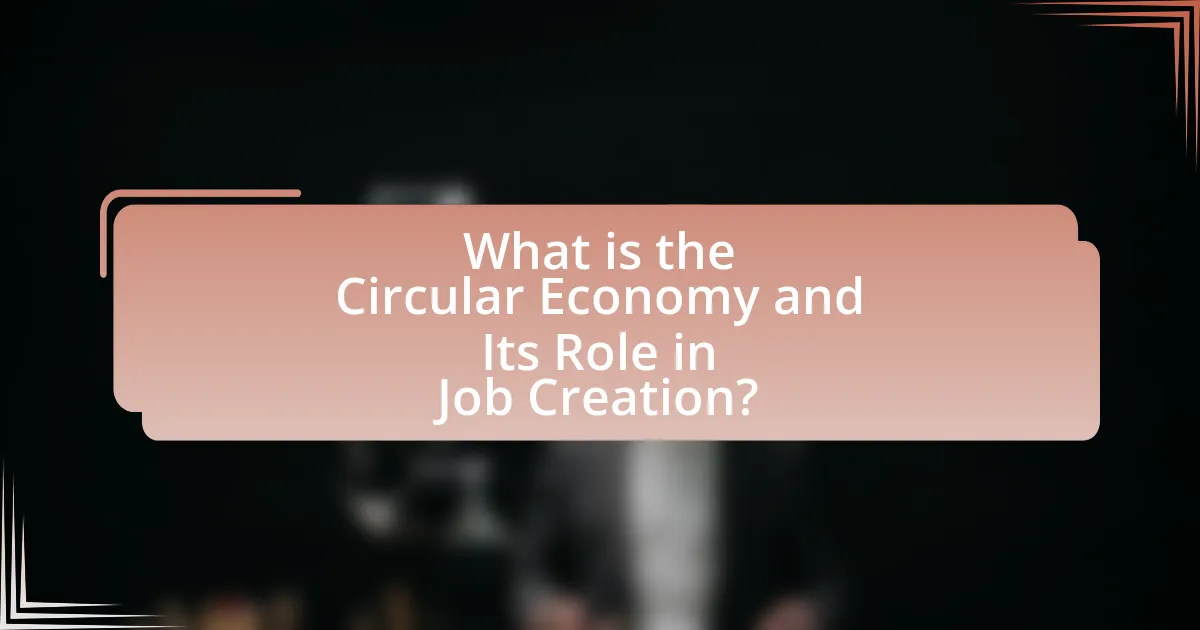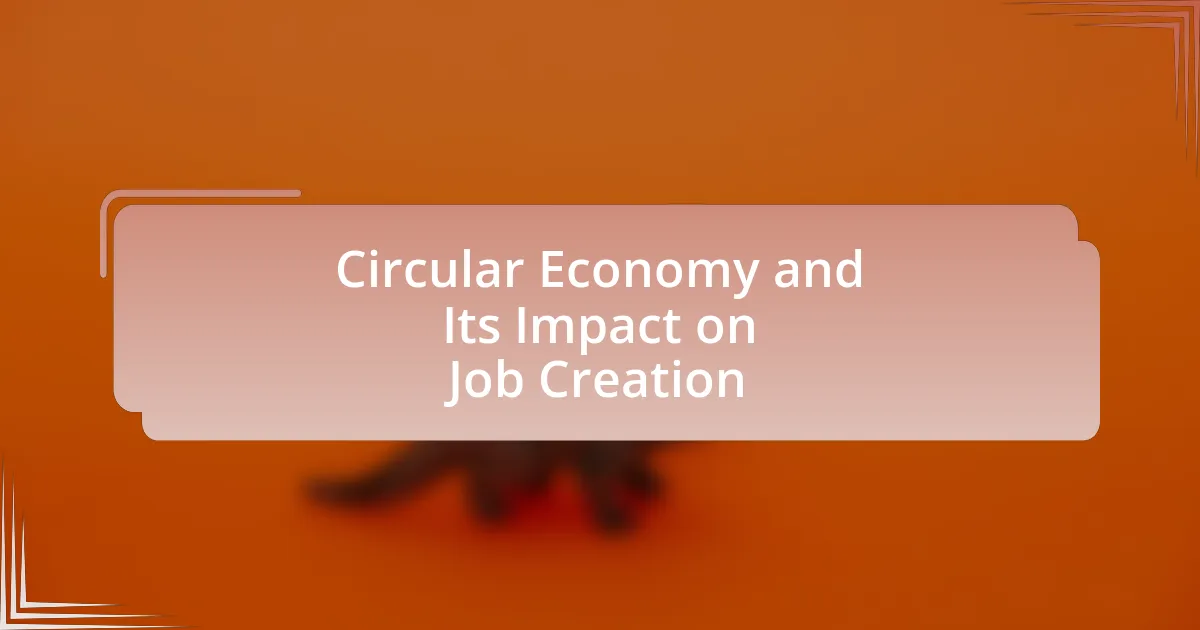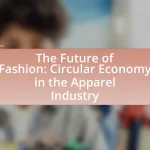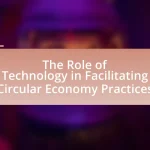The Circular Economy is an economic model that prioritizes the continuous use of resources through recycling, reusing, and refurbishing, significantly contributing to job creation across various sectors. This article explores the differences between the Circular Economy and the Traditional Economy, highlighting key principles such as resource efficiency and waste minimization. It discusses the potential for job growth, estimating that transitioning to a Circular Economy could create millions of jobs in Europe by 2030, particularly in recycling, repair, and sustainable product design. Additionally, the article addresses the challenges and opportunities presented by this economic shift, the role of small and medium enterprises, and the skills needed for future employment in a Circular Economy.

What is the Circular Economy and Its Role in Job Creation?
The Circular Economy is an economic model that emphasizes the continual use of resources by promoting recycling, reusing, and refurbishing products to minimize waste. This model plays a significant role in job creation by fostering new industries and job opportunities in sectors such as recycling, repair, and sustainable product design. According to a report by the Ellen MacArthur Foundation, transitioning to a circular economy could create 700,000 jobs in the European Union alone by 2030, highlighting its potential to drive employment growth while also addressing environmental challenges.
How does the Circular Economy differ from the Traditional Economy?
The Circular Economy differs from the Traditional Economy primarily in its approach to resource use and waste management. In a Circular Economy, resources are reused, recycled, and regenerated, aiming to minimize waste and create a closed-loop system, whereas the Traditional Economy typically follows a linear model of “take, make, dispose,” leading to significant waste generation. This distinction is supported by the fact that the Circular Economy can reduce resource extraction by up to 70% and lower greenhouse gas emissions, as evidenced by a report from the Ellen MacArthur Foundation, which highlights the potential for significant environmental benefits and economic opportunities through circular practices.
What are the key principles of the Circular Economy?
The key principles of the Circular Economy include designing for longevity, maintaining product value, and minimizing waste. These principles emphasize creating products that are durable and can be easily repaired, reused, or recycled, thereby extending their lifecycle. For instance, the Ellen MacArthur Foundation highlights that a circular economy aims to keep resources in use for as long as possible, reducing the need for new raw materials and minimizing environmental impact. This approach not only conserves resources but also fosters innovation and job creation in sectors focused on sustainability and resource efficiency.
How does the Circular Economy promote sustainability?
The Circular Economy promotes sustainability by minimizing waste and maximizing resource efficiency. This model encourages the continual use of resources through practices such as recycling, reusing, and refurbishing products, which reduces the demand for new materials and lowers environmental impact. For instance, a study by the Ellen MacArthur Foundation highlights that transitioning to a circular economy could reduce global greenhouse gas emissions by 39% by 2030, demonstrating its potential to significantly contribute to sustainability efforts.
Why is Job Creation Important in the Context of the Circular Economy?
Job creation is crucial in the context of the circular economy because it fosters sustainable economic growth while reducing environmental impact. The circular economy emphasizes resource efficiency and waste reduction, which leads to the development of new industries and job opportunities in sectors such as recycling, remanufacturing, and sustainable product design. According to a report by the Ellen MacArthur Foundation, transitioning to a circular economy could create 1.8 million jobs in Europe alone by 2030, demonstrating the significant potential for employment growth linked to sustainable practices.
What types of jobs are created through Circular Economy practices?
Circular Economy practices create jobs in various sectors, including recycling, waste management, product design, and repair services. For instance, the recycling industry alone has been shown to generate significant employment opportunities; a report from the Recycling Partnership indicates that recycling and reuse activities support over 1.1 million jobs in the United States. Additionally, jobs in product design focus on creating sustainable products that are easier to recycle or repurpose, while repair services provide employment by extending the life of products, reducing waste. These roles contribute to a more sustainable economy by promoting resource efficiency and reducing environmental impact.
How does the Circular Economy influence employment rates in various sectors?
The Circular Economy positively influences employment rates across various sectors by creating new job opportunities in recycling, repair, and sustainable product design. For instance, a report by the Ellen MacArthur Foundation indicates that transitioning to a Circular Economy could generate 700,000 jobs in the European Union by 2030, particularly in sectors such as waste management and resource recovery. Additionally, sectors focused on sustainable practices, like renewable energy and eco-friendly manufacturing, are experiencing growth, leading to increased demand for skilled labor. This shift not only enhances job creation but also promotes workforce development in green technologies, aligning with global sustainability goals.
What are the Challenges and Opportunities of the Circular Economy for Job Creation?
The circular economy presents both challenges and opportunities for job creation. One significant challenge is the need for workforce retraining, as traditional industries may decline while new sectors emerge, requiring different skills. For instance, a report by the Ellen MacArthur Foundation highlights that transitioning to a circular economy could displace jobs in linear manufacturing but create new roles in recycling and resource recovery. Conversely, opportunities arise from the potential for job growth in sustainable industries, with estimates suggesting that the circular economy could generate up to 1.4 million jobs in Europe alone by 2030, as reported by the European Commission. This shift not only fosters innovation but also promotes sustainable practices, aligning economic growth with environmental stewardship.
What barriers exist in transitioning to a Circular Economy?
Barriers in transitioning to a Circular Economy include lack of awareness, insufficient infrastructure, and economic resistance. Lack of awareness among businesses and consumers hinders the adoption of circular practices, as many do not understand the benefits or methods of implementation. Insufficient infrastructure, such as recycling facilities and supply chain systems, limits the ability to process materials sustainably. Economic resistance arises from the initial costs associated with transitioning to circular models, which can deter investment despite long-term savings and environmental benefits. These barriers collectively impede the shift towards a more sustainable economic framework.
How can businesses leverage Circular Economy principles to create jobs?
Businesses can leverage Circular Economy principles to create jobs by focusing on sustainable practices such as recycling, remanufacturing, and resource recovery. These practices not only reduce waste but also stimulate new job opportunities in sectors like waste management, product design, and repair services. For instance, a report by the Ellen MacArthur Foundation indicates that transitioning to a circular economy could create 1.8 million jobs in Europe alone by 2030, highlighting the potential for significant employment growth through sustainable initiatives. By investing in circular business models, companies can enhance their operational efficiency while contributing to job creation in emerging green sectors.
How does the Circular Economy Impact Different Industries?
The Circular Economy significantly impacts various industries by promoting sustainable practices that reduce waste and enhance resource efficiency. For instance, in the manufacturing sector, companies adopting circular principles can lower production costs by reusing materials, which can lead to a reduction in raw material consumption by up to 30%, as reported by the Ellen MacArthur Foundation. In the fashion industry, brands implementing circular models can extend product life cycles through recycling and upcycling, which not only minimizes environmental impact but also creates new job opportunities in repair and refurbishment services. Additionally, the construction industry benefits from circular economy practices by utilizing recycled materials, which can decrease landfill waste and lower project costs, as evidenced by a study from the World Economic Forum indicating that circular construction could save the industry $1 trillion annually. Overall, the Circular Economy fosters innovation and job creation across multiple sectors by encouraging sustainable practices and resource optimization.
Which industries are most affected by the shift to a Circular Economy?
The industries most affected by the shift to a Circular Economy include manufacturing, construction, textiles, and electronics. Manufacturing is impacted as companies adopt sustainable practices to reduce waste and enhance resource efficiency, leading to changes in production processes. The construction industry is affected through the increased use of recycled materials and sustainable building practices, which promote resource recovery. The textiles sector faces transformation as brands shift towards sustainable materials and recycling initiatives to minimize environmental impact. Lastly, the electronics industry is influenced by the need for product longevity and recycling programs, which aim to reduce e-waste and promote sustainable consumption. These shifts are driven by regulatory changes, consumer demand for sustainability, and the need for resource efficiency.
What role do small and medium enterprises play in job creation within the Circular Economy?
Small and medium enterprises (SMEs) play a crucial role in job creation within the Circular Economy by driving innovation, promoting sustainable practices, and creating local employment opportunities. SMEs are often more agile than larger corporations, allowing them to quickly adapt to circular business models that focus on resource efficiency, waste reduction, and product lifecycle management. According to a report by the European Commission, SMEs account for 99% of all businesses in the EU and are responsible for approximately 70% of job creation, highlighting their significant impact on employment. Furthermore, SMEs contribute to the Circular Economy by developing new products and services that utilize recycled materials, thereby fostering a sustainable job market that aligns with environmental goals.
What are the Future Trends in Circular Economy and Job Creation?
Future trends in circular economy and job creation include the growth of green jobs, increased demand for recycling and waste management roles, and the rise of sustainable product design positions. The circular economy emphasizes resource efficiency and waste reduction, leading to an estimated 24 million jobs globally by 2030, as reported by the International Labour Organization. This shift towards sustainability is driving innovation in sectors such as renewable energy, where jobs in solar and wind energy are projected to expand significantly. Additionally, the transition to a circular economy fosters new business models, such as product-as-a-service, which require skilled workers in areas like maintenance and repair, further contributing to job creation.
How is technology shaping the future of jobs in the Circular Economy?
Technology is significantly shaping the future of jobs in the Circular Economy by enabling innovative processes that enhance resource efficiency and sustainability. Automation and digital platforms facilitate the recycling and repurposing of materials, leading to new job opportunities in sectors such as waste management, product design, and renewable energy. For instance, a report by the Ellen MacArthur Foundation highlights that transitioning to a circular economy could create 700,000 jobs in the European Union by 2030, driven by advancements in technology that optimize resource use and reduce waste. Additionally, technologies like IoT and AI improve supply chain transparency and efficiency, further supporting job creation in sustainable industries.
What skills will be in demand in a Circular Economy?
Skills in demand in a Circular Economy include systems thinking, resource management, and sustainable design. Systems thinking enables individuals to understand complex interdependencies within ecosystems and supply chains, which is crucial for optimizing resource use. Resource management skills are essential for efficiently utilizing materials and minimizing waste, as evidenced by the growing emphasis on recycling and upcycling practices in various industries. Sustainable design skills focus on creating products that are environmentally friendly and can be reused or recycled, aligning with the principles of a Circular Economy. According to the Ellen MacArthur Foundation, the transition to a Circular Economy could create 700,000 jobs in the European Union by 2030, highlighting the increasing demand for these skills.
What Practical Steps Can Businesses Take to Foster Job Creation in the Circular Economy?
Businesses can foster job creation in the circular economy by implementing sustainable practices such as resource recovery, product redesign, and local sourcing. By focusing on resource recovery, companies can create jobs in recycling and waste management sectors, which are essential for a circular economy. For instance, the Ellen MacArthur Foundation reports that transitioning to a circular economy could create 1.8 million jobs in Europe alone by 2030 through increased recycling and reuse initiatives. Additionally, redesigning products for longevity and recyclability encourages innovation and can lead to new job opportunities in engineering and design. Local sourcing of materials not only supports community economies but also reduces transportation emissions, further enhancing sustainability. These practical steps demonstrate a clear pathway for businesses to contribute to job creation while promoting environmental stewardship.
How can companies implement Circular Economy strategies effectively?
Companies can implement Circular Economy strategies effectively by adopting practices such as resource recovery, product life extension, and sustainable design. These practices enable businesses to minimize waste and maximize resource efficiency. For instance, according to the Ellen MacArthur Foundation, transitioning to a circular economy could generate $4.5 trillion in economic benefits by 2030, highlighting the financial viability of these strategies. Additionally, companies can engage in partnerships with stakeholders to create closed-loop systems, ensuring that materials are reused and recycled, which further supports job creation in sectors focused on sustainability and innovation.
What best practices should businesses adopt to maximize job creation?
Businesses should adopt sustainable practices and invest in circular economy initiatives to maximize job creation. By focusing on resource efficiency, waste reduction, and recycling, companies can create new job opportunities in sectors such as waste management, renewable energy, and sustainable manufacturing. For instance, a report by the Ellen MacArthur Foundation indicates that transitioning to a circular economy could generate 700,000 jobs in the European Union alone by 2030. Additionally, fostering innovation through collaboration with local communities and educational institutions can enhance workforce skills, further driving job creation.


